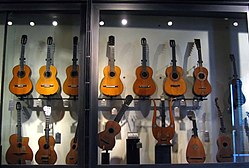
The following outline is provided as an overview of and topical guide to guitars:
Contents
- Instrument classification
- Types and varieties of guitars
- Standard guitar variations
- Pitch-based variations
- Steel guitars
- Courses
- Extra strings
- Fewer strings
- Misc
- Models
- 6-strings
- Bass guitars
- Parts
- Guitar accessories
- Miscellaneous
- Guitar amplifiers
- Guitar effects
- Guitar software
- Guitar use
- Guitar music
- Guitar tunings
- Guitar playing styles
- Guitar technique
- History of guitars
- Guitar makers
- Guitar magazines
- Guitar music 2
- Guitar festivals
- Guitar community
- Significant guitarists
- Guitar methodologies
- See also
- References
- External links
A guitar is a plucked string instrument, usually played with fingers or a pick. The guitar consists of a body with a rigid neck to which the strings, generally six in number, are attached. Most guitar necks have metal frets attached (the exception is fretless bass guitars). Guitars are traditionally constructed of various woods and strung with animal gut or, more recently, with either nylon or steel strings. Some modern 2010-era guitars are made of polycarbonate materials. Guitars are made and repaired by luthiers. There are two primary families of guitars: acoustic and electric. An acoustic guitar has a wooden top and a hollow body. An electric guitar may be a solid-body or hollow body instrument, which is made louder by using a pickup and plugging it into a guitar amplifier and speaker. Another type of guitar is the low-pitched bass guitar.
